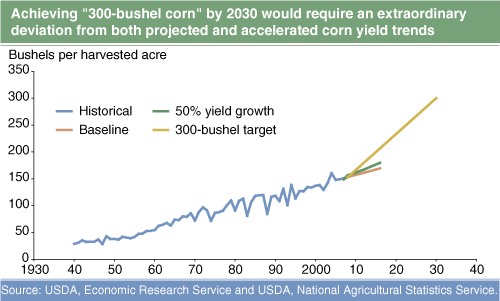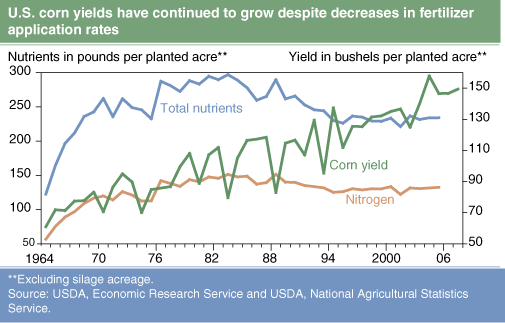Science, Technology, and Prospects for Growth in U.S. Corn Yields
- by Paul Heisey
- 12/1/2009
Highlights
- Recent increases in inflation-adjusted crop prices have sparked renewed interest in the potential for continued increases in crop yields.
- Although market forces and biological factors both influence corn yields, research investments have been a major factor behind continued increases in corn yields.
- Continued scientific advances could accelerate the rate of growth in corn yields, but achieving a nationwide yield of 300 bushels per acre by 2030 would require a tripling of the projected growth rate, and would be historically unprecedented.
Potential increases in crop yields could affect food security, bioenergy production, and the Nation’s response to climate change. Even though the recent sharp increase in crop prices has abated, some analysis suggests that the long-term decline in real (adjusted for inflation) crop prices may have leveled off in the past 10 to 20 years. Crop yields are only one measure of productivity, but they underpin changes in real crop prices and can influence food security.
Many factors were behind the 2007-08 increases in crop prices, but public concern centered on the increasing use of corn in bioenergy production, and its associated impacts on cropland use and food costs. Increasing corn yields can mitigate the impacts of biofuel-related demand for feedstock. A longer term public concern is the effect of global climate change on the food supply, and the ability of the agricultural sector to help mitigate global warming. Genetic combinations in crops that are optimal for present growing conditions may not be optimal if temperatures rise and weather patterns become more erratic. Thus, climate change might alter longrun trends in crop yields. But the development and use of new crop varieties and replacement of one crop by another might better accommodate global climate change. Investment in scientific research can significantly increase corn yields in the face of changing demand or changing climate.
Projecting Future Crop Yields Is Not Easy
Crop yield projections are usually accomplished by looking at past trends, examining new technologies expected to come into widespread commercial use, or both (see box, “Scientific Advances, Economic Factors, and Biological Limits Determine Crop Yields Over Very Long Periods of Time”). Debate over the growth in biofuel production and global warming has elicited a number of corn yield growth scenarios. The National Corn Growers Association “increased yield” scenario of 180 bushels per harvested acre by 2016 is consistent with previous research-driven accelerations in yield growth. On the other hand, increases of 6 bushels or more per acre per year, necessary to reach the widely publicized goal of “300-bushel corn” by 2030, would be completely unprecedented.
Agricultural research, traditionally funded by the public sector but increasingly by the private sector, has been a major factor driving past increases in corn yields. Following the introduction of commercial corn hybrids in the 1930s, U.S. corn yields have trended upward dramatically. For a long time, this increased yield was also supported by increasing use of inputs such as chemical fertilizers. But since about 1980, corn yields have continued to increase even as fertilizer application rates have leveled off or declined. Many factors have contributed to these historical yield increases, including the change from open-pollinated to hybrid corn, other genetic improvements, commercial nitrogen application, herbicide use, and large increases in the number of plants seeded on each acre.
Eventually, there are absolute biological limits on crop yields; but for the most part, neither experimental plots nor sectorwide averages show signs of deceleration in U.S. corn yield growth. A number of technological and environmental factors could influence future corn yields. Improved hybrids that are currently available or now undergoing testing, such as seeds combining multiple genetically engineered traits, can reduce yield gaps caused by pests and diseases, as well as drought, extreme temperatures, and other stresses. Future genetic changes to the corn plant could also increase photosynthetic efficiency, further increasing yield potential. Precision management, such as variable-rate fertilizer application, might have some impact on yields, though its impact is likely greater on profitability of corn production. A changing climate could have countervailing effects. The effects of increased carbon dioxide levels are uncertain for corn, but could be positive, and longer growing seasons could also contribute to increased yields. On the other hand, higher temperatures, lower rainfall, more erratic weather, and more uncertain pest and disease pressure would tend to reduce yields.
Extrapolating past yield trends may help to forecast crop yield growth, but trends differ based on starting points and are not necessarily linear over time. For example, trend growth rates in Illinois corn yields shifted from about 1 bushel per acre per year from 1940 to 1959 to 1.7 bushels from 1960 onward. Further increases in trend yield growth of up to 70-75 percent (i.e., from 2 to 3.5 bushels per acre per year), implicit in the increased yield scenario through 2016, could be consistent with historical experience. Most of the yield growth in an increased yield scenario would result from investments in research that have already been made since there is a long lag between investments in research and the commercial adoption of any resulting change in technologies or practices.
Results from the National Corn Growers Yield Contest have also been used as a proxy for potential corn yields. However, documented yields of 360-370 bushels per acre in this contest depend on optimal growing conditions and intensive management strategies on relatively small plots. For example, the highest yields are often obtained on irrigated land, where moisture is carefully controlled. Extensive irrigation of corn over large areas may not be practical given the availability and price of water. Furthermore, the level of inputs and time spent in managing contest plots may not be profitable in commercial farming.
Currently available technologies appear to be directed at reducing gaps between the largest recorded corn yields and commercially profitable yields. Technologies that increase absolute maximum corn yields by raising photosynthetic efficiency may still be years away. However, the application of science to agriculture has led to impressive gains in corn yields over many years, and there are no signs of deceleration in these gains. National aggregate corn yields should continue a trend of robust growth for the foreseeable future.
This article is drawn from:
- Malcolm, S., Aillery, M. & Weinberg, M. (2009). Ethanol and a Changing Agricultural Landscape. U.S. Department of Agriculture, Economic Research Service. ERR-86.
You may also like:
- Bioenergy. (n.d.). U.S. Department of Agriculture, Economic Research Service.
- Westcott, P. (2009). USDA Agricultural Projections to 2018. U.S. Department of Agriculture, Economic Research Service. OCE-2009-1.
- Trostle, R. (2008). Global Agricultural Supply and Demand: Factors Contributing to the Recent Increase in Food Commodity Prices. U.S. Department of Agriculture, Economic Research Service. WRS-0801.
- Fuglie, K. & Heisey, P. (2007). Economic Returns to Public Agricultural Research. U.S. Department of Agriculture, Economic Research Service. EB-10.
- Day Rubenstein, K., Heisey, P., Shoemaker, R., Sullivan, J. & Frisvold , G. (2005). Crop Genetic Resources: An Economic Appraisal. U.S. Department of Agriculture, Economic Research Service. EIB-2.



